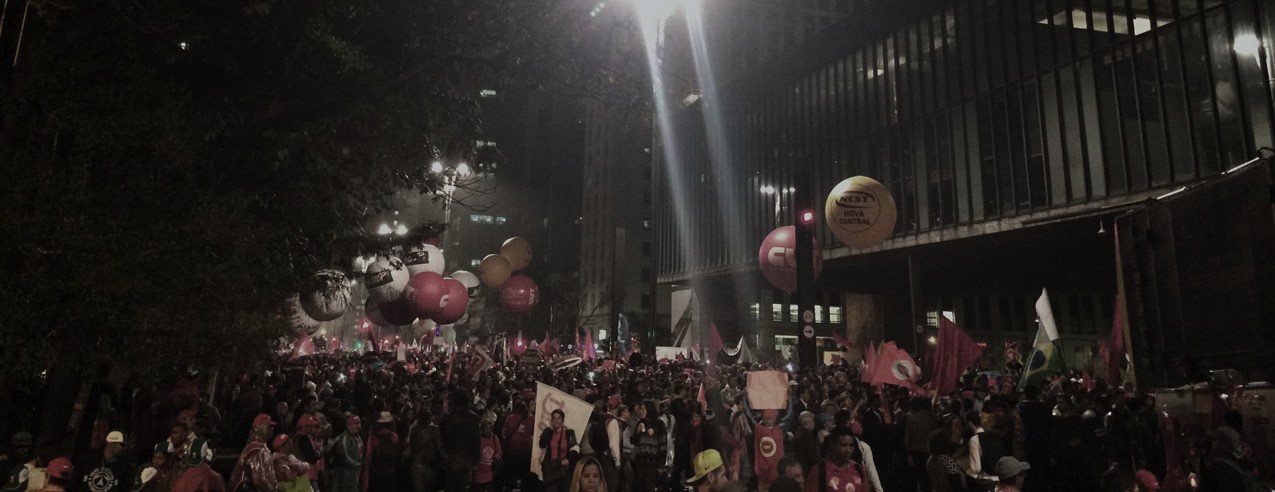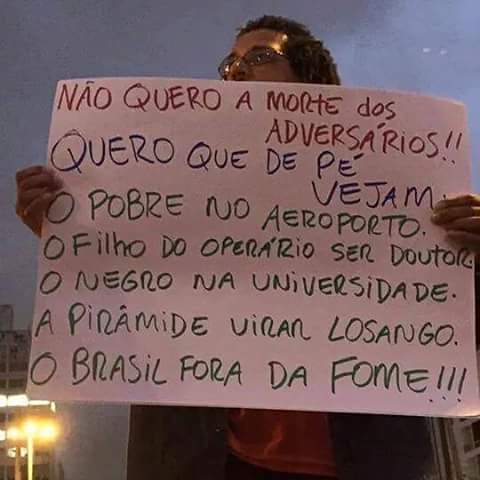Não vai ter golpe! (You won’t have a Coup!).
Brasil’s ‘Silent Left’ did indeed show themselves, across 25 cities. Did the international media show them showing themselves? For the most part, no.
U.S. & U.K. newspapers, which have received criticism for their coverage of political demonstrations across Latin America, were conspicuous by their absence. Going against narrative clearly isn’t popular with anglo media.
Brasil Wire observed and filmed the São Paulo demonstration from its concentration at 5pm, through its march and culmination at 10pm.
Bringing together around 30 Social Movements, Political Parties, Unions and Activist Groups, what we found was an impressive demonstration on a drizzly Thursday evening, a show of left unity that was as articulate & nuanced as it was passionate.
Although Europeans are now accustomed to the horrors of enforced austerity, the concept in Brasil (Adjuste Fiscal) is new, and the closest analogy to this demonstration would be anti-austerity protests in Europe, though crucially against a background of the genuine threat to the country’s democratic stability from both a reactionary elite and international financial interests.
With no coverage from media prior, and minimal during (with some notable exceptions), these kind of mobilisations in an area as wealthy and conservative as central São Paulo are no mean feat. Avenida Paulista, the traditional platform for the most telegenic protests in Brasil runs adjacent to Jardins, one of the wealthiest areas, in which over 90% voted for Aecio Neves in the last election. It is also mere blocks away from another elite district, Higienopolis. This is one of many reasons why straight comparisons between Left/Right protests in São Paulo require more detailed analysis than numbers alone and are rarely in themselves a reliable measure. Often the phrase “bussed-in” is used as if to discredit such left-wing demonstrations – and this casually discards that the vast majority of those present, working class, union members, and so on, live outside the ‘bairros nobres’ of the city where the events take place. One stark difference between Right & Left protests is policing. At the former, protesters can be found taking photographs with Military Police, at Left demonstrations – even “Pro-Government” ones – the atmosphere between police and participants is tense. This isn’t particularly surprising as Military Police are the responsibility of State Government, which in São Paulo is controlled by opposition PSDB.
In Globo news segments that night and the following day – with exception of São Paulo – almost all footage shown was broad daylight. This meant that it was shot before 5pm & before most people arrived from work.
Though there was certainly plenty of outright support for PT and Dilma Rousseff, the overarching message was pro-democracy (anti-coup / anti-impeachment) but also against economic policy – Adjuste Fiscal (Austerity) and the slogan that ‘Agenda Brasil is the real Coup’. This reflects a belief that an ostensibly left government these people elected has ended up adopting an ‘anti-popular’ policy platform to appease elites and markets. ‘Agenda Brasil’ is a package of liberal, market-friendly economic reforms put together in response to the economic downturn & political crisis, which is seen as an attack on coveted workers rights, some of the strongest in the world, which Brazilians have enjoyed since the era of Getulio Vargas.
The demonstration illustrated how it is perfectly coherent to support the democratic & constitutional integrity of the country and still criticise economic policy.
I don’t want to see my adversaries dead.
I want them on their feet to see…
the poor flying on airplanes,
the child of the factory worker becoming a doctor,
black people going to college,
the [class] pyramid turned upside down,
Brazil without hunger.
One small anti-capitalist youth group – Rua – made it clear with their banners & signs that they consider Finance Minister Joaquim Levy, Senate Leader Renan Calheiros, VP Michel Temer, and the President herself, Dilma Rousseff, all equally responsible for Agenda Brasil.
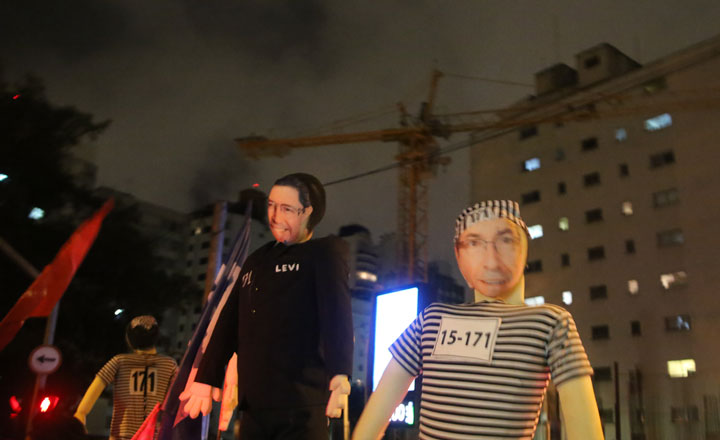
Eduardo Cunha, the hated congressional speaker, was was unsurprisingly the most common target. During the demonstration news broke that he faced massive corruption charges, involving $80m USD in bribes laundered through his evangelical church.
Another recurring slogan was “The people can not pay for the crisis”.
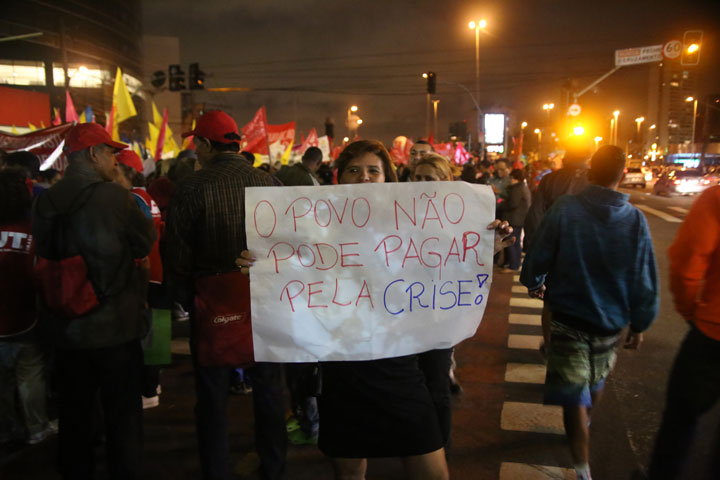
CUT, one of the largest Trade Union Confederations in the world was naturally the most visible group, given that their members wear distinctive branded clothing. Elsewhere there was a myriad of progressive organisations & causes, from those protesting reduction of penal age and legalisation of outsourcing, through to Black Women’s groups and also a small group representing Haitian immigrants.
The 18 names of those massacred in Osasco & Barueri, an atrocity suspected to have been carried out by Military Police, were read out by speakers, and each victim was represented by a sign carried through the parade.
Guillerme Boulos, powerful orator and leader of social movement MTST, reiterated that this demonstration, in its size and diversity represented the majority, the reality of Brasil – in comparison to the far narrower & wealthier demographic found at pro-impeachment demonstrations on Avenida Paulista such as which took place the previous Sunday.
Video summary of the event from Carta Capital containing interviews with participants & organisers.
For Twitter users, the tags #JornalistasLivres #BrasilDeDemocracia reveal a variety of professional and amateur coverage from demonstrations across the country.
Timeline
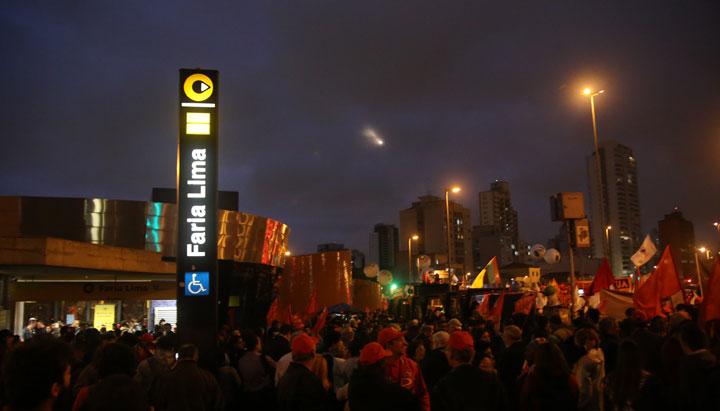
4pm-6pm Largo da Batata: Slowly grew towards our estimate of around 40k following speeches at 6:30pm, by which point organisers were announcing 60. This was shortly before parade began to assemble on Faria Lima, with MTST at head, with many still arriving after work via the Metro & Bus. Numbers were still also coming on foot via Reboucas, Pinheiros and neighbouring streets, as well as from districts the other side of Marginal Pinheiros.
7pm-9pm Avenida Rebouças: The route between the concentration and Avenida Paulista. Brasil Wire filmed most of the main parade (besides some small groups who went ahead early) from the same point on the corner of Oscar Freire & Rebouças.
9pm-10pm Avenida Paulista: Once the march reached Paulista it looked considerably larger in size with a significant concentration over 2 lanes from MASP at Peixoto Gomide along to Augusta where it thinned to single lane to accommodate traffic. The arriving march joined groups at Paulista who had had not been present during concentration at Largo da Batata.
São Paulo Attendance
Organisers: 100,000
Military Police: 40,000
(It was estimated that around 200,000 took part nationally)
Brasil Wire filmed the various stages of the demonstration over a 5 hour period from 5-10pm across 3 locations.
Practically unedited, the resulting video is an hour long. Importantly it contains a segment within which the entire Largo da Batata block passes at a single point which we envisaged would be useful for analysis. Not only does the viewer get a sense of scale, but also the diversity of the movement and messages on display.
Given how little coverage left-wing demonstrations that go against the anti-government narrative get in English language media, we thought it more valuable to post the video in its entirety as a document.
